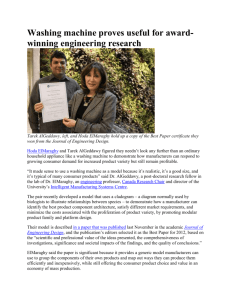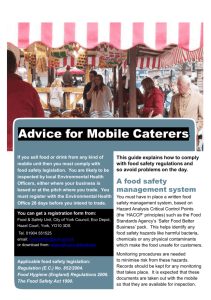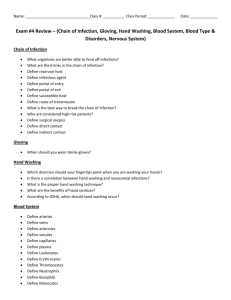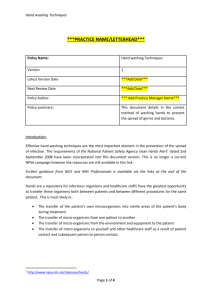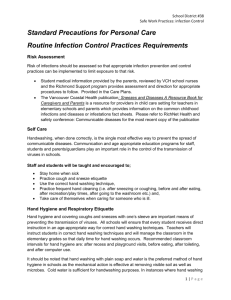Personal Hygiene Training - Small Scale Food Processor
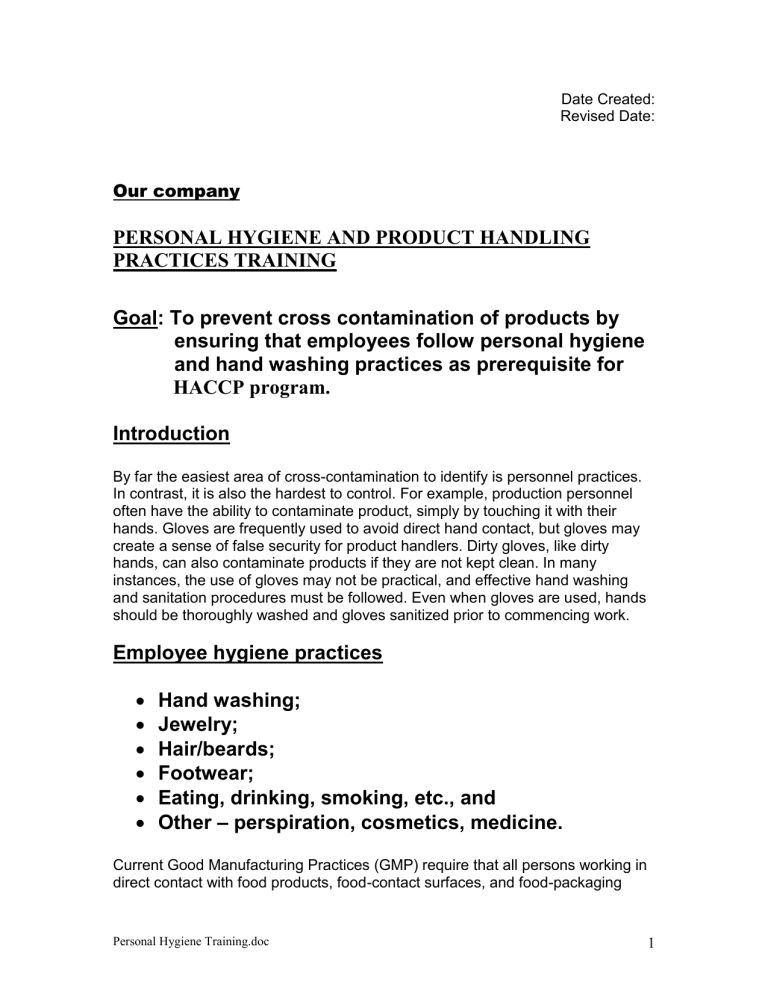
Date Created:
Revised Date:
Our company
PERSONAL HYGIENE AND PRODUCT HANDLING
PRACTICES TRAINING
Goal: To prevent cross contamination of products by ensuring that employees follow personal hygiene
and hand washing practices as prerequisite for
HACCP program.
Introduction
By far the easiest area of cross-contamination to identify is personnel practices.
In contrast, it is also the hardest to control. For example, production personnel often have the ability to contaminate product, simply by touching it with their hands. Gloves are frequently used to avoid direct hand contact, but gloves may create a sense of false security for product handlers. Dirty gloves, like dirty hands, can also contaminate products if they are not kept clean. In many instances, the use of gloves may not be practical, and effective hand washing and sanitation procedures must be followed. Even when gloves are used, hands should be thoroughly washed and gloves sanitized prior to commencing work.
Employee hygiene practices
Hand washing;
Jewelry;
Hair/beards;
Footwear;
Eating, drinking, smoking, etc., and
Other – perspiration, cosmetics, medicine.
Current Good Manufacturing Practices (GMP) require that all persons working in direct contact with food products, food-contact surfaces, and food-packaging
Personal Hygiene Training.doc 1
materials conform to hygienic practices while on duty to the extent necessary to protect against contamination of food. The methods for maintaining cleanliness include, but are not limited to:
1. Washing hands thoroughly (and sanitize if necessary to eliminate undesirable microorganisms) in a designated hand-washing facility before starting work, after each absence from the work station for example, going for breaks or to toilet, and at any other time when the hands may have been soiled or contaminated.
2. Removing all jewelry and other objects that might fall into mix, equipment, and containers.
3. Wearing, where appropriate and in effective manner, hairnets and beard covers where applicable. Hair in food can be a source of both microbiological and physical contamination. Production personnel should be required to keep their hair clean and appropriate hair and/or beard restraints should be worn at all times in production areas.
4. Boots may transfer contaminants to workers hands when dressing or may track contaminants into processing areas. An ideal situation would be for plant employee to change their footwear before starting work.
5. Eating food, chewing gum, drinking beverages, or smoking should not occur in any areas of operation including where equipment or utensils are washed. Healthy people frequently harbour pathogens in their mouth and respiratory tract. When activities such as eating, drinking, or smoking that involves hand to mouth contact occur, pathogens can be transferred to employee’s hands and then to products that they handle. These activities should not occur in production areas, and hands should be washed when employees return to work areas after engaging in these activities.
Establishing an Effective Hand Washing Program
Training for hand washing is an essential part of sanitation program.
Unfortunately, it takes only a few untrained or uncooperative employees handling final product to create a sanitation contamination problem.
The importance of hand washing is not fully appreciated by most employees.
Data show that a significant number of food handlers do not wash hands or do not use proper techniques. After all, bacteria and other contaminants are not visible. Unfortunately, when an untrained employee cannot see contaminants on their hands, they may assume there is no need to wash them. For the most part, supervisors cannot determine the con dition of employees’ hands by visual inspection. Systematic procedures and a routine hand-washing schedule are
Personal Hygiene Training.doc 2
essential to controlling the spread of contaminants from employees’ hands to food.
In order to have an effective hand-washing program, employees must grasp the importance of keeping themselves clean. For example, an employee may think that because hands are routinely washed and sanitized that food product can be safely handled. However, if this same employee is habitually touching soiled or contaminated clothing, hair or face and other body parts, then cross contamination is occurring. Hand washing procedures must be part of an ongoing training program.
How to Wash Hands
The primary purpose of hand washing is to remove unwanted microbiological and other contaminants.
Remove jewelry;
Wet hands with warm water (43
C or 110
F);
Lather and rub using warm water:
Rinse
Dry with disposable paper towels; and
Avoid recontamination.
To facilitate the proper washing and sanitizing of hands, remove jewelry and other objects that hide and protect soil and bacteria. Wedding bands, watches, bracelets and other arm and wrist ornaments are not acceptable. Fingernails should be clipped and filed. Hands should not have any infections, wounds or sores since hand washing will not remove pathogenic bacteria associated with these conditions. It is important to stress to employees that merely applying sanitizer to hands will not read of pathogenic microorganism. Soils, such as fats, oils, and other dense, difficult to remove materials, will protect microorganisms from sanitizing agents.
Generally, the first step for manual hand washing is to thoroughly wet exposed hands (including the back of the hands) with warm water. Warm water (43
C or
110
F) is essential in good hand washing procedures. It softens some soil material and facilitates emulsification of soil material with the cleaning compound.
Introduce ample soap and vigorously rub hands together to produce an abundant lather. Liquid soap in a dispenser is probably the least messy way to distribute soap onto hands. Processors must be sure that soaps and detergents intended for hand washing facilities are specifically for hands. A good basic soap that has been approved by government agency is adequate for most operations.
Personal Hygiene Training.doc 3
Many food processing establishments use antimicrobial soaps and detergents.
Studies have indicated that antimicrobial soaps are no more effective than regular soaps in removing unwanted microorganisms from exposed hands. Care should be exercised if an anti-microbial soap is routinely used as part of a company’s hand washing program. It is possible that improperly used overused that some of these soaps may cause skin irritations.
Supervisor should demonstrate and have employees practice the lathering procedures and the feel of the proper temperature of water. In addition, employees should be able to determine proper timing through practice.
Remember, lathering and rubbing for 20 seconds followed by a through rinsing in clean water is minimum. Employees may have to scrub longer depending on the soil build up or contamination of hands. Done properly, hand washing will remove most microorganisms of concern.
Clean, disposable paper towels should be available to thoroughly dry hands after washing. Improperly drying of hands could actually create cross contamination problems. For example, properly cleaned hands dried on soiled or contaminated towels would have negative effect for the best-intended hand washing effort.
How to Sanitize Hands
When necessary, hand sanitizing should immediately follow hand washing to destroy any remaining microorganisms. Hand sanitizing chemicals should be safe to the individual and should not pose a contamination problem for the food product. There are numerous types of commercially available hand sanitizing solutions. At Pacific Blends, Bactisan an alcohol based with moisturizer that has been approved by regulatory agency is used as a hand sanitizer.
When to Wash and Sanitize Hands
An essential part of an effective hand-washing program is knowing when to wash and sanitize. It is not enough to instruct employees to wash when hands are dirty or soiled. There are specific times to wash:
After using the washroom;
After coughing, sneezing, using handkerchief or disposable tissue, smoking, eating, or drinking;
After handling soiled equipment or utensils; and
Before commencing work or when changing tasks so as to prevent cross-contamination.
Personal Hygiene Training.doc 4
Management’s Role in Employee Hygiene
Set policies that outline personal hygiene expectation;
Set policies for employees with an illness;
Training;
Monitoring and enforcement; and
Provide adequate employee facilities
Management must also play a role in helping employees prevent crosscontamination. Management should provide a clear understanding of the personal hygiene practices and company policies regarding illness and other health conditions, such as infected wounds that could contaminate products.
Training programs designed to help employees understand exactly what is expected of them and why it is important should be utilized. Management should continually emphasize how it is for employees to maintain a high level of cleanliness and good health and should serve as role models for good work habits and acceptable hygienic practices. Management should also take steps to ensure that visitors are required to follow the same hygienic practices as employees, and have policies in place that prevent unauthorized personnel from being in production areas. Management should also assume responsibility for providing properly located and maintained facilities and equipment that will allow employees to adhere to personal hygiene requirements including: a) Dressing or changing rooms that are adequate and properly maintained. b) Laundry services and/or uniform services as necessary. c) Designated employee areas for breaks where eating and drinking is allowed.
Personal Hygiene Training.doc 5

